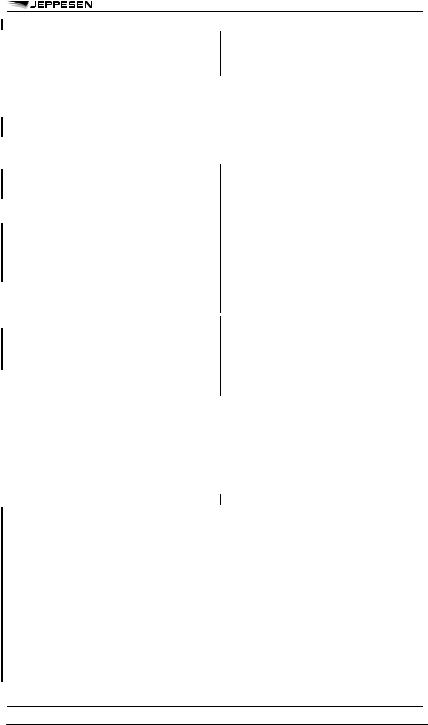
EMERGENCY
.pdf
26 NOV 10 EMERGENCY FRANCE-11
FRANCE - ICAO DIFFERENCES OR STATE SPECIAL PROCEDURES
–leave the IAF at this level to perform the known or estimated approach procedure until landing.
Leaving Procedure
If the second attempt for landing fails divert towards aerodrome stated in flight plan and climbing to the minimum safe enroute altitude.
Departure Procedure
–In VMC: Return for landing on the departure aerodrome or continue towards an appropriate aerodrome.
–In IMC: Continue SID to the TMA boundary at the last assigned flight level or, if this is not compatible with the minimum safe altitude, continue climb up to the cruising level. Thereafter, continue according to the current flight plan.
RENNES TMA
Dinard (Pleurtuit-St. Malo)
Arrival Procedure
In case the pilot did not receive information on the runway-in-use he shall apply procedures published for RWY 35 (a circle-to-land procedure may be required if the wind observed by the pilot indicates RWY 17 in use).
In case of a missed approach carry out published missed approach procedure and commence a second approach. If the second attempt for landing fails, leave the TMA at 3000ft and try to reach VMC.
Departure Procedure
Continue your flight to the TMA boundary at the last assigned flight level, or, if this is not compatible with obstacles in the vicinity, proceed at the minimum safe altitude. Then climb to the cruising level indicated in the current flight plan.
Rennes (St Jacques)
Arrival Procedure
In case the pilot does not have knowledge of the run- way-in-use carry out instrument approach procedure for RWY 28 (eventually followed by a circle-to-land procedure if the wind observed by the pilot indicates that RWY 10 is in use).
In case of missed approach, follow published missed approach procedure and perform another approach.
Leaving Procedure
If the second approach for landing fails, climb to 3000ft on SID ARE 2T or ARE 2V. When established on R-286 of VOR ‘RNE’ (magnetic track 286°), climb to FL40 towards VOR ‘ARE’ and try to reach VMC.
Departure Procedure
–In VMC: Return for landing on the aerodrome.
–In IMC: Continue SID to the TMA boundary at the last assigned flight level or, if this is not compatible with obstacles in the vicinity, proceed at the minimum safe altitude. Thereafter, continue according to the current flight plan.
RODEZ TMA
Rodez (Marcillac)
Arrival Procedure
Follow the authorized arrival route. In case of radar guidance, proceed to the initial STAR.
–proceed to the IAF at the last assigned and acknowledged flight level, if this level is available in the holding pattern, otherwise the highest level in the holding;
–stay in the holding at this level until the latest time of the following:
•EAT,
•Arrival time in the holding pattern plus 10 minutes;
–then decent in the holding pattern.
–leave the IAF at this level to perform the known or estimated approach procedure until landing.
In case the pilot does not know the runway-in-use, comply with the published approach procedure for RWY 31 (a circle-to-land procedure may be required if the wind observed by the pilot indicates that RWY 13 is in use).
If landing is impossible during the regulation time, follow the leaving procedure.
Leaving Procedure
Divert towards aerodrome stated in flight plan complying with a suitable SID or omnidirectional departure climbing to the minimum safe enroute altitude.
Departure Procedure
–In VMC: Return for landing on the aerodrome.
–In IMC: Continue SID to the TMA boundary at the last assigned flight level or, if this is not compatible with obstacles in the vicinity, proceed at the minimum safe altitude. Thereafter, continue according to the current flight plan.
ROUEN TMA
Rouen/Vallee de Seine
Leaving Procedure
If the second attempt for landing fails, climb to 3200ft, leave the CTR and TMA via ELBOX-L’Aigle VOR ‘LGL’ and try to reach VMC.
Departure Procedure
–In VMC: Return for landing on the aerodrome.
–In IMC: Continue SID to the TMA or CTR boundary at the last assigned flight level or, if this is not compatible with obstacles in the vicinity, proceed at the minimum safe altitude. Thereafter, continue according to the current flight plan.
SEINE TMA
Troyes (Barberey)
Leaving Procedure
Leave the TMA along departure route via VOR ‘TRO’ to NDB ‘AX’ at the minimum safe level and try to reach VMC.
© JEPPESEN, 1993, 2010. ALL RIGHTS RESERVED.

FRANCE-12 |
EMERGENCY |
26 NOV 10 |
FRANCE - ICAO DIFFERENCES OR STATE SPECIAL PROCEDURES
Departure Procedure
–In VMC: Return for landing on the aerodrome.
–In IMC: Continue SID to the TMA boundary at the last assigned flight level or, if this is not compatible with obstacles in the vicinity, proceed at the minimum safe altitude. Thereafter, continue according to the current flight plan.
STRASBOURG TMA
Strasbourg (Entzheim)
Arrival Procedure
In case the pilot does not have knowledge of the run- way-in-use carry out instrument approach procedure for RWY 23. (Eventually a circle-to-land procedure will have to be performed if the wind observed by the pilot indicates that RWY 05 is in use.)
Leaving Procedure
If the second approach fails leave the TMA along SID BERUG 7J (in case of RWY 05) or along SID POGOL 7H (in case of RWY 23) climbing to FL90 and try to reach VMC.
Departure Procedure
–In VMC: Return for landing on the aerodrome.
–In IMC: Continue SID to the TMA boundary at the last assigned flight level or, if this is not compatible with obstacles in the vicinity, proceed at the minimum safe altitude. Thereafter, continue according to the current flight plan.
ST. YAN TMA
St. Yan
Leaving Procedure
If the second approach for landing fails follow SID LESPI 4N or 4S depending on the runway-in-use and try to reach VMC.
Departure Procedure
–In VMC: Return for landing on the aerodrome.
–In IMC: Continue SID to the TMA boundary at the last assigned flight level or, if this is not compatible with obstacles in the vicinity, proceed at the minimum safe altitude. Thereafter, continue according to the current flight plan.
TOULON CTA
Hyeres (Le Palyvestre)
Arrival Procedure
Proceed initially to NDB ‘TLN’ and thereafter to the alternate aerodrome.
TOULOUSE TMA
Agen (La Garenne)
Arrival Procedure
Join or follow the STAR assigned or the very next one by default. Proceed to the IAF at the last assigned and acknowledged flight level, if usable in the holding pattern, or failing this, at the highest flight level of the holding pattern. Perform the holding pattern at this altitude until the EAT or 10 minutes after entering
holding, then descend. Depart the IAF and perform the approach procedure according to the standard procedure for the runway in use.
In case the pilot does not know the runway-in-use, comply with the published approach procedure followed by a circle-to-land, if required.
Radio failure followed by a missed approach: if landing is impossible during the regulation time, follow the leaving procedure.
Leaving Procedure
Same procedure as under Toulouse.
Departure Procedure
–In VMC: Return for landing on the aerodrome.
–In IMC: Continue SID to the TMA boundary at the last assigned flight level or, if this is not compatible with obstacles in the vicinity, proceed at the minimum safe altitude. Thereafter, continue according to the current flight plan.
Toulouse
Arrival Procedure
TOULOUSE (BLAGNAC)
Join or follow the STAR assigned or the very next one by default. Proceed to the IAF (see Special Cases) at the last assigned and acknowledged flight level, if usable in the holding pattern, or failing this, at the highest flight level of the holding pattern. Perform the holding pattern at this altitude until the EAT or 10 minutes after entering holding, then descend, in holding, to FL80. Depart the IAF (see Special Cases) and perform the approach procedure.
In case the pilot does not know the runway-in-use, comply with the published approach procedure for RWY 14 (a circle-to-land procedure may be required if the wind observed by the pilot indicates that RWY 32 is in use).
Radio failure followed by a missed approach: if landing is impossible during the regulation time, follow the leaving procedure.
TOULOUSE (FRANCAZAL)
Join or follow the STAR assigned or the very next one by default. Proceed to the IAF at the last assigned and acknowledged flight level, if usable in the holding pattern, or failing this, at the highest flight level of the holding pattern. Perform the holding pattern at this altitude until the EAT or 10 minutes after entering holding, then descend, in holding, to FL80. Depart the IAF and perform the approach procedure for RWY 12 (a circle-to-land procedure may be required if the wind observed by the pilot indicates that RWY 30 is in use).
Radio failure followed by a missed approach: if landing is impossible during the regulation time, follow the leaving procedure.
Special Cases
Arrivals from ASPET, TAN, TBO continue to SURAS at the last assigned flight level.
© JEPPESEN, 1993, 2010. ALL RIGHTS RESERVED.

26 NOV 10 |
EMERGENCY |
FRANCE-13 |
FRANCE - ICAO DIFFERENCES OR STATE SPECIAL PROCEDURES
Leaving Procedure
Divert to the flight planned alternate complying with a suitable SID or omnidirectional departure climbing to the minimum safe enroute altitude, or to FL70 for airports located within the lateral limits of the TMA.
Departure Procedure
–In VMC: Return for landing on the aerodrome using circuit East of aerodrome.
–In IMC: Continue flight to the TMA boundary at the last assigned flight level or, if this is not compatible with obstacles in the vicinity, proceed at the minimum safe altitute. Thereafter, continue according to the current flight plan.
Albi (Le Sequestre), Carcassonne (Salvaza) and Castres (Mazamet)
Arrival Procedure
Join or follow the STAR assigned or the very next one by default. Proceed to the IAF at the last assigned and acknowledged flight level, if usable in the holding pattern, or failing this, at the highest flight level of the holding pattern. Perform the holding pattern at this altitude until the EAT or 10 minutes after entering holding, then descend. Depart the IAF and perform the approach procedure according to the standard procedure for the runway in use.
In case the pilot does not know the runway-in-use, comply with the published approach procedure followed by a circle-to-land, if required.
Radio failure followed by a missed approach: if landing is impossible during the regulation time, follow the leaving procedure.
Leaving Procedure
Same procedure as under Toulouse.
Departure Procedure
Same procedure as under Toulouse.
© JEPPESEN, 1993, 2010. ALL RIGHTS RESERVED.

7 JAN 11 |
EMERGENCY |
GERMANY-1 |
GERMANY - ICAO DIFFERENCES OR STATE SPECIAL PROCEDURES
GENERAL
In general, the Emergency, Unlawful Interference, Communications Failure, Interception and Search and Rescue procedures are in conformity with the Standards, Recommended Practices and Procedures in ICAO Annexes and Documents.
COMMUNICATIONS FAILURE
INSTRUMENT METEOROLOGICAL CONDITIONS
If the flight is conducted in accordance with instrument flight rules, the pilot shall:
a.set the transponder to Code 7600; and
b.maintain the last assigned speed and level or the minimum IFR cruising altitude for a period of 7 minutes. If the minimum IFR cruising altitude is higher than the last assigned level, the pilot shall climb to the minimum IFR cruising altitude. The period of 7 minutes commences at the time:
1.the last assigned level or minimum IFR cruising altitude is reached, or
2.when the transponder is set to Code 7600; whichever is later.
NOTE: If, for any reason, pilots of singleor dou- ble-seated jet aircraft are unable to adhere to the procedures of observing the period of 7 minutes, they shall set the transponder to Code 7700 and follow the procedures below.
c.after a period of 7 minutes, adjust level and speed in compliance with the filed flight plan;
NOTE: With regard to changes in level and speed, the filed flight plan, which is the flight plan as filed with an ATS unit, will apply without any subsequent changes.
d.when being radar vectored or proceeding offset according to RNAV without a specified clearance limit as to time or location, proceed in the most direct manner possible to rejoin the current flight plan route not later than the next significant point, taking into consideration the minimum flight altitude applying at the time;
NOTE: With regard to the flight route and/or the beginning of the approach to the destination aerodrome, the current flight plan – which is the flight plan which has been accepted, including changes, if any, brought about by subsequent clearances – will apply.
e.proceed according to the current flight plan route to an established initial approach fix serving the destination aerodrome and
1.hold over this IAF until the time of the last, or approximately last received and acknowledged expected approach time; or
2.in case an expected approach time has not been received and acknowledged, hold until the time of the estimated time of arrival, or as near to it as possible, in compliance with the current flight plan prior to commencing descent.
f.conduct an instrument approach procedure established for the IAF and, if possible, within 30 minutes:
1.land according to the time of arrival last received and acknowledged, or
2.land according to the estimated time of arrival in compliance with the current flight plan, whichever is later.
g.in case a landing cannot be performed, fly to the alternate aerodrome.
NOTE: No compulsory procedures can be established for this exceptional eventuality. Air Navigation Services assumes that approach will be commenced after reaching the IAF.
If for meteorological reasons the pilot of a singleor double-seated jet-aircraft is unable to adhere to the IFR procedures described above and is flying in VMC, the transponder shall be set to Code 7700 and Class ’C’ airspace shall be vacated as soon as possible, observing the visual flight rules. Thereafter, if no further emergency has occurred, the pilot shall reset his transponder to Code 7600 and shall continue according to the procedures for flights in VMC.
If, due to safety or urgent operational reasons, it seems inadvisable to the pilot to continue to the original destination aerodrome, he may divert to another aerodrome which seems suitable to him. In this case, he shall fly on a published routing to an initial approach fix established for this aerodrome and follow the additional procedures shown above.
If a pilot conducting an IFR/VFR flight reaches his clearance limit and is unable to continue his flight as intended in compliance with the weather minima established according to para 28 of the German Aviation Regulation, he shall proceed in accordance with shown above.
VISUAL METEOROLOGICAL CONDITIONS
IFR flights in VMC follow IMC procedures (as described above).
VFR flights in VMC shall adhere to the following exceptions:
a.If the continuation of the flight does not appear advisable or is not possible:
–switch transponder to code 7600
–continue flight in VMC
–land at the nearest suitable aerodrome, and
–report the arrival time of the flight to the responsible ATC unit, as promptly as possible.
b.An aircraft may only enter a control zone if the pilot has previously received a corresponding ATC clearance or if, due to flight operational reasons, a landing at an aerodrome within the control zone is unavoidable.
c.If on a VFR flight, radio communication fails: Pilot shall avoid Class ’C’ airspace below FL 100 or Class ’D’ airspace (not Control Zone) irrespective or whether he has already received an entry clearance.
© JEPPESEN, 1993, 2011. ALL RIGHTS RESERVED.

GERMANY-2 |
EMERGENCY |
7 JAN 11 |
GERMANY - ICAO DIFFERENCES OR STATE SPECIAL PROCEDURES
Within Class ’C’ airspace below FL100 or Class ’D’ airspace (not Control Zone) continue flight in accordance with received and acknowledged ATC clearance, or if not possible, leave this airspace on the shortest route, observing the prescribed visual flight rules.
Within Class ’C’ airspace at or above FL100, leave this airspace by the shortest route observing the visual flight rules.
d.If on a flight with a change from IFR to VFR and the clearance limit is reached, and continuation of flight is in accordance with the prescribed minima, continue flight as prescribed under IMC.
SPECIAL PROCEDURES FOR RNAV TRANSITIONS TO FINAL APPROACH
Aircraft following RNAV ’Transition to Final Approach’ procedures at Berlin (Schönefeld), Berlin (Tegel), Bremen, Dresden, Dusseldorf, Erfurt, Frank- furt-Hahn, Frankfurt/Main, Friedrichshafen, Hamburg, Hannover, Cologne-Bonn, Leipzig-Altenburg, Leipzig-Halle, Lubeck (Blankensee), Munich, Nurnberg, Stuttgart airports and experiencing radio communication failure, are to comply with the following:
a.After receiving a „TRANSITION“ or „TRANSITION AND PROFILE“ clearance, the pilot shall switch to transponder code 7600 immediately and continue the flight in accordance with the lateral and vertical description of the procedure, including assigned speeds with subsequent final leg of a published Standard Instrument Arrival Procedure.
b.After receiving a „DIRECT TO WAYPOINT“ or „VIA WAY POINT...“ clearance without subsequent clearance, the pilot shall switch to transponder code 7600 immediately and continue the flight via the cleared waypoint(s) and the part of a Transition to Final Approach route adjoining it (them), including assigned speeds and altitudes with subsequent final leg of a published Standard Instrument Arrival Procedure. In addition, further details shall be taken from the published procedures established for the individual aerodromes.
If the last waypoint of the cleared Transition to Final Approach procedure is located in front of the common final approach fix/point (FAF/FAP) and/or final approach fix (FAF) of the final approach procedures established for the respective RWY, in case of radio communication failure the pilot-in-command shall follow the RNAV (GPS) instrument approach procedures established for the respective RWY.
EMERGENCY SATELLITE VOICE CALLS FROM AIRCRAFT
For aircraft flying over the Federal Republic of Germany, in case of loss of radio telephony communication, dedicated satellite voice telephone numbers for the following ACCs/UACs have been programmed into the aeronautical Ground Earth Stations of the Inmarsat Signatories.
The allocated airborne numbers for use via the aircraft satellite voice equipment are available H24 as follows:
Bremen ACC |
421102 |
Langen ACC |
421103 & 421104 |
Maastricht UAC |
00871761619227 |
Munich ACC/UAC |
421105 |
Rhein UAC |
421106 |
It must be emphasized that these numbers are for emergency only, for non-routine flight safety calls when all other airborne means of communication with the appropriate ATS unit have failed.
© JEPPESEN, 1993, 2011. ALL RIGHTS RESERVED.

17 APR 09 |
EMERGENCY |
GIBRALTAR-1 |
GIBRALTAR - ICAO DIFFERENCES OR STATE SPECIAL PROCEDURES
GENERAL
In general, the Emergency, Unlawful Interference, Communications Failure, Interception and Search and Rescue procedures are in conformity with the Standards, Recommended Practices and Procedures in ICAO Annexes and Documents.
COMMUNICATIONS FAILURE
If radio contact is lost for more than 10 seconds during final approach in IMC, commence immediate climb to 3900ft QNH. If able to maintain VMC, continue the radar pattern and land on receiving green light from ATC.
© JEPPESEN, 2001, 2009. ALL RIGHTS RESERVED.

4 DEC 09 |
EMERGENCY |
GREECE-1 |
GREECE - ICAO DIFFERENCES OR STATE SPECIAL PROCEDURES
GENERAL
In general, the Emergency, Unlawful Interference, Communications Failure, Interception and Search and Rescue procedures are in conformity with the Standards, Recommended Practices and Procedures in ICAO Annexes and Documents.
COMMUNICATIONS FAILURE
See RADIO COMMUNICATION FAILURE PROCEDURES EUROPE, and supplemented as follows:
ATHENS TMA
Aircraft under Radar Control
In the event of communication failure and in the absence of previous ATC instructions, the pilot should, if unable to execute a visual approach:
–continue by own navigational means, to execute the approach he was vectored for, or
–when vectored to execute a visual approach to Elefsis airport, proceed directly to Aigina NDB ‘EGN’, maintaining the last assigned altitude, if it is higher or equal to 4000ft, and execute one of the instrument approach procedures, as appropriate, without delay.
Aircraft below 4000ft must proceed to ‘EGN’ NDB making an initial climbing turn to 4000ft, taking into account high terrain and obstacles in the vicinity of the airport.
IRAKLION TMA
In the event of communication failure, and in absence of previous ATC instructions, the pilot-in-command shall:
a.if unable to execute a visual approach, continue by its own navigational means to execute the instrument approach he was vectored for;
b.in case he was vectored for a visual approach and still in IMC, he should proceed, by his own navigational means to ‘IRA’ VORDME maintaining the last assigned altitude if higher or equal to 6000ft then proceed to GONSO at 3000ft and execute instrument approach to Rwy 27 or as appropriate for the runway-in-use.
If the last assigned altitude was below 6000ft, an initial climbing turn to 6000ft is necessary before starting the above procedure from ‘IRA’ VORDME.
NOTE: IF ‘IRA’ VORDME is unserviceable the pilot should make an initial climbing turn to 8500ft proceeding to ‘HER’ NDB and execute the Lctr DME approach procedure as appropriate for the runway- in-use.
In all cases pilots must take into account the high terrain in the south sectors of Iraklion airport, and must not enter these sectors at an altitude less than 10000ft.
KERKIRA TMA
In the event of communication failure, and in absence of previous ATC instructions, the pilot-in-command should, if unable to execute a visual approach, continue by his own navigational means to execute the instrument approach he was vectored for. In the case he was vectored for a visual approach to Rwy 17/35, and still in IMC, he should proceed, by his own nav-
igational means to ‘GAR’ VORDME maintaining the last assigned altitude, if it is higher or equal to 4500ft and execute the ‘GAR’ VORDME Rwy 35 instrument approach appropriate for the runway-in-use.
a.aircraft below 4500ft must proceed to ‘GAR’ VORDME, making an initial climbing turn to 4500ft, taking into account high terrain and obstacles in the vicinity of the airport.
b.in case of ‘GAR’ VORDME is unserviceable, the pilot-in-command should use ‘KEK’ NDB and execute the ‘KRK’ VORDME-NDB Rwy 35 procedure.
MAKEDONIA TMA
In the event of complete aircraft communication failure and in the absence of previous ATC instructions, the pilot should, if unable to execute a visual approach, continue by his own navigational means to execute the instrument approach he was vectored for. If he was vectored for a visual approach and still in IMC, he should proceed by his own navigational means to ‘MKR’ VORDME maintaining the last assigned altitude, if higher or equal to 5500ft, execute the ‘MKR’ VORDME instrument approach appropriate for the runway-in-use. If he was vectored for a visual approach to Rwy 28, he should proceed to ‘MKR’ VORDME and execute the ‘MKR’ VORDME for Rwy 34 followed by a circling approach to Rwy 28.
NOTE: Aircraft below 5500ft must proceed to ‘MKR’ VORDME, making an initial climbing turn to 5500ft, taking in account high terrain and obstacles in the vicinity of the airport.
In case ‘MKR’ VORDME is unserviceable, the pilot should use ‘TSL’ VORDME and execute ’TSL’ VORDME approach for RWY 34 followed by a circling approach to runway-in-use.
Climb or descent either after departure, enroute or at the arrival phase at a rate not exceeding 2000ft/min.
Arrange the flight so as to arrive over the most desirable navigational aid, serving the airport of intended landing at or as closely as possible to the time of arrival resulting from the current FPL.
If unable to land at destination, consider the case as emergency, and handle it on ad hoc basis.
RODOS TMA
In the event of complete aircraft communication failure and in the absence of previous ATC instructions, the pilot should, if unable to execute a visual approach, continue by his own navigational means to execute the instrument approach he was vectored for. If he was vectored for a visual approach to runway 07 or 25, and is still in IMC, he should proceed by his own navigational means to ‘RDS’ VORDME maintaining the last assigned altitude, if higher or equal to 6000ft, execute the instrument approach for the runway-in-use.
NOTE: Aircraft below 6000ft must proceed to ‘RDS’ VORDME, making an initial climbing turn to 6000ft, taking in account high terrain and obstacles in the vicinity of the airport.
© JEPPESEN, 1993, 2009. ALL RIGHTS RESERVED.

Eff |
EMERGENCY |
IRELAND-1 |
28 MAY 10 |
IRELAND - ICAO DIFFERENCES OR STATE SPECIAL PROCEDURES
GENERAL
In general, the Emergency, Unlawful Interference, Communications Failure, Interception and Search and Rescue procedures are in conformity with the Standards, Recommended Practices and Procedures in ICAO Annexes and Documents.
EMERGENCY
RESCUE AND FIRE FIGHTING SERVICE
Whenever an emergency has been declared at an aerodrome where this service is notified, aircraft may communicate direct with the Fire Service on frequency 121.60MHz prior to initial request via ATC.
Aerodrome |
Callsign |
Dublin |
Dublin Fire |
Shannon |
Shannon Fire |
COMMUNICATIONS FAILURE
See RADIO COMMUNICATION FAILURE PROCEDURES EUROPE.
DESIGNATED NAVIGATIONAL AIDS
Aircraft experiencing communication failure shall use the following navigation aids/holdings:
Aerodrome |
Navigation Aid/Holding |
Cork |
ROVAL for RWY 17 |
|
GODSA for RWY 35 |
|
UPLOM for RWY 07 |
|
GINGI for RWY 25 |
Dublin ACC NORTH |
ROKNA for ILS approach |
(All Routes North of |
RWY 28 |
extended centerline |
ROKNA for ILS approach |
RWY 10/28) |
RWY 16 |
|
DINIL for ILS approach |
|
RWY 10 |
Dublin ACC SOUTH |
TULSO for ILS approach |
(All Routes South of |
RWY 28 |
|
|
extended centerline |
NASRI for ILS approach |
RWY 10/28) |
RWY 10 |
|
NASRI for ILS approach |
|
RWY 16 |
Shannon |
Ennis NDB ‘ENS’ for ILS |
|
approach RWY 24 |
|
ELPOM for ILS approach |
|
RWY 06 |
DEPARTURE PROCEDURE
General
A controlled IFR flight operating in IMC, having acknowledged an initial or intermediate clearance to climb to a level other than the one specified in the current flight plan for the enroute phase of the flight, and experiencing two-way radio communication failure should, if no time or geographical limit was included in the climb clearance, maintain for a period of three minutes, the level to which it was cleared and then continue its flight in accordance with the current flight plan.
Aircraft Being Radar Vectored
A departing IFR flight being radar vectored away from the current flight plan route and experiencing two-way radio communication failure should proceed in the most direct manner to the route specified in the current flight plan.
CORK CTA/CTR
Arrival Procedure
a.Traffic cleared on a STAR and experiencing a communication failure shall follow the STAR at the last cleared level or altitude. On reaching the appropriate holding fix, descent to 3000ft and complete the Instrument Approach Procedure appropriate to the runway in use.
b.Aircraft being radar vectored to final approach should join, in the most expeditious manner, and complete the Instrument Approach Procedure appropriate to the runway in use.
If unable to comply or uncertain of position, climb immediately to 3000ft QNH, proceed in the most expeditious manner to the hold appropriate to the runway in use and complete the Instrument Approach Procedure appropriate to the runway in use.
Departure Procedure
Aircraft experiencing communication failure shall comply with the following procedures:
a.RFL below FL80: Departing traffic cleared by ATC to a level/altitude below the RFL, shall comply with communication failure procedure as outlined in ICAO Annex 2.
b.RFL above FL80; Departing traffic cleared by ATC to a level/altitude below FL80 shall maintain the cleared level for a period of three minutes following the time the altitude/level is reached and thereafter adjust level and speed in accordance with filed flight plan.
Departing traffic experiencing a communication failure above FL80 shall comply with communication failure procedure as outlined in ICAO Annex 2.
NOTE: CAT A, B aircraft may be assigned a Departure appropriate to CAT C, D aircraft at the discretion of ATC.
DUBLIN CTA/CTR
Arrival Procedure
a.Traffic cleared on a STAR and experiencing a communication failure shall follow the STAR at the last cleared level or altitude. On reaching the appropriate holding fix, descent to 6000ft and complete the Instrument Approach Procedure appropriate to the runway in use.
b.Aircraft being radar vectored to final approach should join, in the most expeditious manner, and complete the Instrument Approach Procedure appropriate to the runway in use.
c.When area EID1 is active, route to the hold in use and thereafter complete the Instrument Approach Procedure for the runway-in-use. When RWY28 or RWY34 is in use aircraft
© JEPPESEN, 1993, 2010. ALL RIGHTS RESERVED.

IRELAND-2 |
EMERGENCY |
Ef |
28 MAY 10 |
IRELAND - ICAO DIFFERENCES OR STATE SPECIAL PROCEDURES
should use GIMRO hold rather than ROKNA and thereafter route direct to the IF for RWY28 or RWY34 as appropriate.
Departure Procedure
a.Aircraft experiencing communications failure on a SID where no cruising level has been specified in the enroute clearance (i.e., no specified level in the Current Flight Plan), the climb, after the appropriate time interval, shall be to the level contained in the Filed Flight Plan.
b.Aircraft routing LIFFY SID experiencing communication failure and expecting a transition to BOYNE, should continue to LIFFY and route, in the most expeditious manner, to BOYNE to join the current flight plan route. Maintain the last assigned level for a period of three minutes then climb to the cruising level specified in the current flight plan.
KERRY CTR
Departure Procedures
Traffic departing on SIDs SHA 1A, SHA 1C, SHA 2A, SHA 2C, CRK 1A, CRK 1C, CRK 2A and CRK 2C, experiencing radio communication failure in the Kerry CTR/Shannon CTA shall maintain the maximum altitude specified in the SID for a period of three minutes following the time the altitude is reached and thereafter adjust level and speed in accordance with filed flight plan.
SHANNON CTA/CTR
Arrival Procedure
a.Aircraft cleared on a STAR and experiencing a communication failure shall follow the STAR at the last cleared level or altitude. On reaching the appropriate holding fix, descend to 3000ft and complete the Instrument Approach Procedure appropriate to the runway in use.
b.Aircraft being radar vectored to final approach should join, in the most expeditious manner, and complete the Instrument Approach Procedure appropriate to the runway in use.
If unable to comply or uncertain of position, climb immediately to 3000ft QNH, proceed in the most expeditious manner to the hold appropriate to the runway in use and complete the Instrument Approach Procedure appropriate to the runway in use.
Departure Procedure
Aircraft experiencing communication failure in Shannon CTA/CTR shall comply with the following procedures:
a.RFL below FL80: Departing traffic cleared by ATC to a level/altitude below the RFL, shall comply with communication failure procedure as outlined in ICAO Annex 2.
b.RFL above FL80: Departing traffic cleared by ATC to a level/altitude below FL80 shall maintain the cleared level for a period of three minutes following the time the altitude/level is reached and thereafter adjust level and speed in accordance with filed flight plan.
Departing traffic experiencing a communication failure above FL80 shall comply with communication failure procedure as outlined in ICAO Annex 2.
NORTH ATLANTIC TRAFFIC
The following procedures apply to oceanic aircraft intending to enter or exit NAT airspace via Shannon FIR/UIR/SOTA/NOTA and experiencing communications failure. The procedures are intended to complement and not supersede State procedures/regulations.
General
a.The pilot shall operate the SSR transponder on identity Mode A Code 7600 and Mode C.
b.The pilot shall also attempt to contact any ATC facility (on VHF or HF) or another aircraft to inform of the difficulty and request relay of information to the ATC unit with whom communications are intended.
Communications Failure Prior to Entering NAT Oceanic Airspace
Due to the potential length of time in oceanic airspace, it is strictly recommended that a pilot experiencing communications failure whilst still in Shannon FIR/UIR/SOTA/NOTA does not enter the Shanwick Oceanic Control Area but adopts the procedure specified at para a) below.
However, if the pilot elects to continue then, to facilitate the provision of adequate separation, adopt either the procedure at para b) or c) below.
a.For this procedure the pilot is deemed to have selected Shannon as the aerodrome of intended landing. Proceed, maintaining the last assigned and acknowledged flight level, to the appropriate navigation aid specified for Shannon and hold over that aid for a period of not less than 5 minutes. Then commence descent and complete a normal instrument approach for that navigational aid. The rate of descent shall be at the pilot’s discretion. For this procedure and to avoid ambiguity Shannon is the only Irish aerodrome which may be used.
b.If operating with a received and acknowledged oceanic clearance, the pilot shall enter oceanic airspace at the cleared oceanic entry point, level and speed and proceed in accordance with the oceanic clearance. Any level or speed changes required to comply with the oceanic clearance shall be completed within Shannon FIR/UIR/SOTA/NOTA in the vicinity of the oceanic entry point.
c.If operating without a received and acknowledged oceanic clearance, the pilot shall enter oceanic airspace at the first oceanic entry point, level and speed, as contained in the flight plan and proceed via the filed flight plan route to landfall. Maintain the first filed oceanic level and speed to landfall. Any level or speed changes required shall be completed within Shannon FIR/UIR/SOTA/NOTA in the vicinity of the oceanic entry point.
© JEPPESEN, 1993, 2010. ALL RIGHTS RESERVED.

Eff |
EMERGENCY |
IRELAND-3 |
1 MAY 09 |
IRELAND - ICAO DIFFERENCES OR STATE SPECIAL PROCEDURES
Communications Failure Prior to Exiting
NAT Oceanic Airspace
a.If cleared on flight plan route, proceed in accordance with the last received and acknowledged oceanic clearance to the last specified oceanic route point, normally landfall, and maintain the last assigned oceanic level and speed to this point. Unless the pilot elects to adopt the procedure outlined at para c) below, after landfall proceed in accordance with the Filed Flight Plan.
b.If cleared on other than flight plan route, proceed in accordance with the last received and acknowledged oceanic clearance to the last specified oceanic route point, normally landfall. Unless the pilot elects to adopt the procedure outlined at para c) below, after passing this point, rejoin the filed flight plan route by proceeding, via the published ATS route structure where possible, to the next significant point ahead of the track of the aircraft as contained in the filed flight plan and continue on the flight plan route. Maintain the last assigned oceanic level and speed to landfall, thereafter the flight level and speed contained in the filed flight plan.
c.In the event of the pilot electing to divert to Shannon, after landfall proceed direct to the appropriate navigation aid specified for Shannon maintaining the last assigned oceanic level and hold over that aid for a period of not less than 5 minutes. Then commence descent and complete a normal instrument approach for that navigational aid. The rate of descent shall be at the pilot’s discretion. For this procedure and to avoid ambiguity Shannon is the only Irish aerodrome which may be used.
© JEPPESEN, 1993, 2009. ALL RIGHTS RESERVED.
